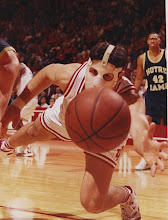In the band's native land, Business as Usual spent 9 weeks at the top of the album charts. Internationally, it was #1 on the UK album charts for 5 weeks, topped the album charts in Canada, New Zealand, and Norway. It was the #1 album on the year-end album charts for 1982 in both Australia and Canada. In the U.S., the album spent a ridiculous 15 consecutive weeks at #1 on the Billboard album chart, from November 1982 to February 1983 -- only to be outdone by its successor, Michael Jackson's Thriller, which spent the next 17 weeks (and 37 of the next 60 weeks) at #1. It ended up at #2 on the Billboard Year End album chart for 1983 (behind Thriller). Business as Usual has gone 6x platinum in the U.S.
And, of course, Business as Usual produced the band's two most enduring and recognizable hits. "Who Can It Be Now?" went to #1 on the Billboard Hot 100, #1 in Israel, #2 in Australia, and Top 10 in Canada, Italy, and South Africa.
Then there was "Down Under," essentially an Australian tourism song, which introduced the rest of the world various Australian slang terms and, of course, Vegemite, the notoriously horrible tasting dark brown paste that is essentially made from the byproducts of the beer brewing process. I've never had it, but every one of my Australian friends has, without exception, has told me that it's one of the worst-tasting foods on the planet. But anyway, "Down Under" was an even bigger hit than "Who Can It Be Now?" It topped the charts in Australia, Canada, Denmark, Ireland, New Zealand, Switzerland, the UK, and the U.S., and it reached the Top 10 on the pop charts in at least seven other countries. It was also #4 on the Billboard Hot 100 year-end chart for 1983 and came in at #219 on the all-time Billboard Hot 100 chart.
In January 1983, Men at Work became the first Australian artist to have a #1 album on the Billboard album chart and #1 song on the Billboard Hot 100 ("Down Under") at the same time. They did the same thing in Australia, New Zealand, and the UK too. And thanks to the strength of Business as Usual, Men at Work won the Grammy for Best New Artist in 1983.
The band made two more albums before breaking up in 1985 (though several band members were kicked out prior to the third album), and they never quite achieved the same success with their subsequent albums as with Business as Usual. But let's all be glad that we at least got this one. For my favorite songs from each side, I'm going to go with something other than "Who Can It Be Now?" and "Down Under," not only because I just talked about both of them, but also because you probably already know those, so no need to highlight them.
Favorite song from Side 1: "Helpless Automation"
In addition to the two massive hits we discussed above, Side 1 is very solid, as the other three songs are all great new wave pop songs. I decided to go with "Helpless Automation" because it's the most new wavey. Sung by keyboardist/saxophonist/flutist Greg Ham -- rather than usual lead singer Colin Hay -- it sounds like it should be the background music during a scene in an '80s movie when the tween characters are really buckling down to make that robot they need to make to win the local "Valley Innovation Challenge" competition, thereby winning the $10,000 first prize, which is just enough money to save Happy Time Arcade -- the local arcade, owned and operated by one of the character's grandfather, an affable middle-aged widower named Manny (played masterfully by Gregory Peck, earning him an Oscar nom for Best Supporting Actor), who cares more about having a place for local kids to hang out and have fun than making a profit -- from being foreclosed on by Garfield Building & Loan (headed by the dastardly Horace Garfield, played masterfully by Kevin McCarthy, earning him an Oscar nom for Best Supporting Actor) by 9:00 p.m. on the very night of the Valley Innovation Challenge. Can they win the competition? And more importantly, even if they do, will they be able to get the money to the mortgage company in time to save the arcade? And what part will the robot play in all of this? Head to theaters this summer to find out.
Favorite song from Side 2: "Be Good Johnny"
A play on the title of Chuck Berry's classic "Johnny B. Goode," this song is told from the point of view of a nine-year-old day dreaming boy who is always told to be good. The intro to the song is reminiscent of the intro to U2's "Where the Streets Have No Name" (or vice versa, since that came out six years after "Be Good Johnny"), but much shorter, before turning into a new wave gem. The song wasn't released as a single in the U.S. (so it wasn't eligible for the Billboard Hot 100), but it went to #8 on the Australian pop charts and #3 in New Zealand, as well as #3 on the Billboard Top Tracks chart (which is now the Mainstream Rock Tracks chart).






No comments:
Post a Comment